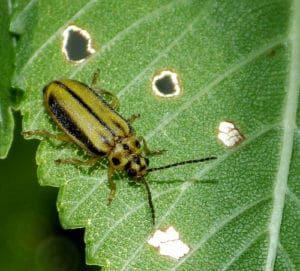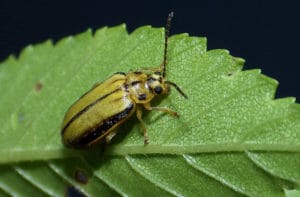Fall is here, Jack-o-lanterns are aglow, and everyone’s looking for a good scare. As Portland certified arborists, we’re always on the lookout for a certain type of creepy-crawlies—the pests that plague trees. Insect pests can cause tree disease and death, costing thousands of dollars every year in tree treatment and replacement.
Damaging insects are generally categorized by the type of harm they cause.
—Sap-Feeding Insects use piercing and sucking mouthparts to access and extract the tree’s sap. They are the vampires of the tree world.
—Defoliating Insects eat plants’ leaves; this may or may not lead to tree death.
—Woodboring Insects drill through the outer bark to feed on inner bark and transport tissue, including phloem and xylem. (Transport tissue circulates nutrients and water throughout the plant.) Each type of pest insect causes a unique form of damage. Let’s explore this more as we consider a few tree pests specific to our state.
Pests that are Harmful to Oregon Trees
Aphids & Scales
Damage these pests can cause: Curled leaves with honeydew, a sticky, shiny substance which the pests secrete as they feed on sap. With enough damage, the leaves or needles may turn yellow and fall off completely. If enough leaves are destroyed, the tree may die. However, the more common death by aphid or scale occurs when these tiny pests spread fungal tree diseases.
Signs that you could have an infestation: Sooty mold, ants farming the honeydew by tending the aphids, curling leaves with wet, shiny surface.
Aphids and scales may beset many Pacific Northwest species, including dogwood, ash, lilac, maple, pines, spruce, and Douglas fir. Most species of trees suffer species-specific aphids and/or scale pests.
Elm Leaf Beetle
Damage this pest can cause: Elm leaf beetle larvae skeletonize leaves by eating all the tender material while leaving structural veins in place. Adult elm leaf beetles chew circular holes in leaves (also known as “shot holes” to arborists). If enough defoliation occurs, leaves may fall early and sections of the infested tree may die back.
Signs that you could have an infestation: Look for skeletonized leaves, shot holes, clusters of eggs laid on leaves in the spring, and larvae moving down the stems prior to pupation.
Elm leaf beetles are known to attack all manner of elms, including Siberian, English, American, and other elm species.
Bronze Birch Bore Beetles
Damage this pest can cause: Adult beetles cause minimal harm as they feed on birch leaves. However, the larvae of this species can cause significant damage. Adults lay eggs in cracks, under bark cracks, and in damaged areas of the tree. After the eggs have hatched, the larvae chew deeper into the bark, and they begin feeding on the phloem and xylem tissues. These larvae galleries inhibit the tree’s ability to distribute water and nutrients. Eventually, the tree may suffer dieback at its crown; if the infestation is not stopped, dieback can continue into the main stem, eventually causing tree death.
Signs that you could have an infestation: Look for 1/8”, D-shaped exit holes. These are created when the adult beetle leaves its larvae feeding gallery. Dieback at the crown is another clue that you may have a bronze birch bore beetle infection on your hands. Finally, you may be able to detect larvae chambers as bumps or ridges underneath bark.
This species attacks birches including European, Himalayan, and other ornamental birches. European and Asian birches are more susceptible to Bronze Birch Borers; native birch species with non-white bark are more resistant to the beetles, as both species evolved together.
Tree pests can be scary for arborphiles like us. But what’s really terrifying is the thought of relying on noxious chemicals to handle  tree infestation problems. Massive bee deaths can be caused by certain tree pesticides—and this is only one of many negative environmental impacts. Organic pest control is not only possible; it can also be effective, if you’re working with the right Portland tree service. Call us to quell your tree pest fears. Urban Forest Pros always seeks to use organic options first; we only turn to more traditional chemical solutions when all other options have been exhausted. Give us a call for more advice on how to organically treat and prevent tree pest infestations.
tree infestation problems. Massive bee deaths can be caused by certain tree pesticides—and this is only one of many negative environmental impacts. Organic pest control is not only possible; it can also be effective, if you’re working with the right Portland tree service. Call us to quell your tree pest fears. Urban Forest Pros always seeks to use organic options first; we only turn to more traditional chemical solutions when all other options have been exhausted. Give us a call for more advice on how to organically treat and prevent tree pest infestations.